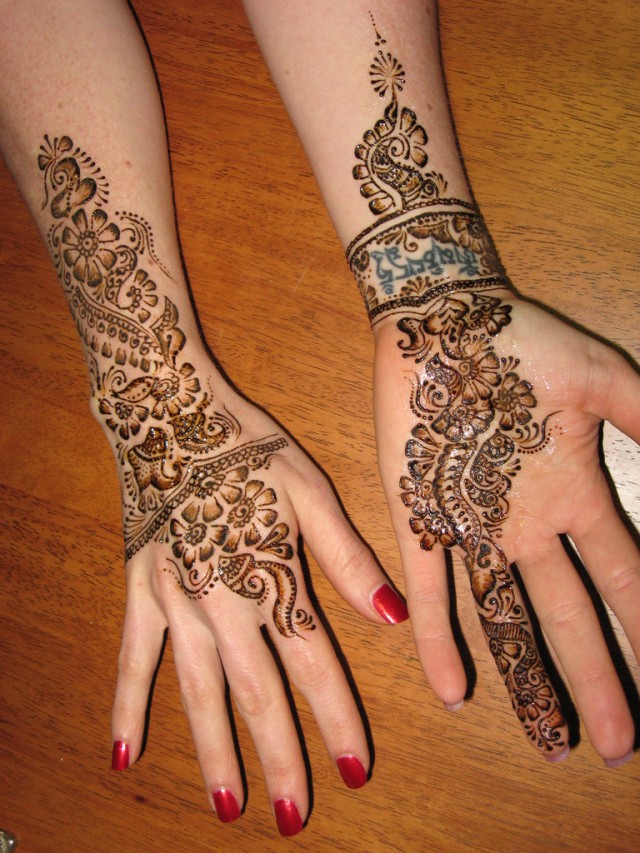Arabic Mehndi Design (1)Biogarphy Photos Pictures Pics Images
Source(google.com.pk)Centuries of migration and cultural interaction make the task of determining henna’s exact origin a complex one. However, historians argue that henna has been used for at least 5,000 years in both cosmetic and healing capacities.
Some researches argue henna originated in ancient India while others claim it was brought to India by Egyptian moghuls in the 12th century C.E. Still others will contend that the tradition of applying henna to the body began in the Middle East and North Africa in ancient times.
Archaeological research indicates henna was used in ancient Egypt to stain the fingers and toes of Pharaohs prior to mummification. But research also argues the Pharaohs were not the only Egyptians to use henna. Ancient Egyptians and many indigenous and aboriginal people around the world believed that the naturally derived red substances of ochre, blood and henna had qualities that improved human awareness of the earth’s energies. It was therefore applied to help people keep in touch with their spirituality.
Ani, a mummified scribe (1400BC), had fingernails stained with henna. There are also several medieval paintings depicting The Queen of Sheba decorated with henna on her journey to meet Solomon.
Ancient and Traditional, Henna has been used for centuries for body decoration. Ancient Egyptians used henna prior to mummification. People all over the world continue to use henna, primarily for cosmetic purposes. However, in countries where henna is rooted in historical tradition, members of the working class more commonly apply henna for medicinal and healing purposes, as well as connection to Spirit.
In Cairo, Egypt, for example, many working class citizens had their hands and feet dipped in henna to produce a solid covering, which differs from the common decorative design that is usually applied for weddings and other celebrations.
As a healing plant, henna conditions, cleanses, colors and cools the skin. When applied to hair, it has the same effect. Millions of Asian and African people regularly apply henna to their hair. In these regions, henna is inexpensive, readily available, and helps to cool the scalp in the hot summer months.
Throughout time henna has been associated with special celebrations. Betrothals, weddings, the eighth month of pregnancy, the birth, the 40th day after a woman gives birth, naming ceremonies, etc, are all events celebrated with henna. Eids, and other religious holidays are also occasions to be hennaed. There are also some healing ceremonies, like the Zar in North Africa, which include its use. A common practice seen in India and in the Islamic world is the pre-wedding tradition of ‘Night of Henna’ parties, like the Sudanese one described earlier.
The art form of henna decorating has been practiced in Northern Africa, the Middle East, Southern Asia, and Europe and has been used by Hindus, Sikhs, Jews, Moslems, Christians, Pagans, and others; and varies from region to region. Varying designs have a different meaning for members of each culture, such as good health, fertility, wisdom, protection and spiritual enlightenment. The most popular traditional use is tied closely with weddings and bridal preparation; these designs tend to be the most ornate, covering the most area. Depending on the culture, men may use it as well as women, usually for more symbolic purposes; masculine designs are generally very basic, simple and small in design.
Arabic Mehndi Design (1)Photos Pictures Pics Images
Arabic Mehndi Design (1)Photos Pictures Pics Images
Arabic Mehndi Design (1)Photos Pictures Pics Images
Arabic Mehndi Design (1)Photos Pictures Pics Images
Arabic Mehndi Design (1)Photos Pictures Pics Images
Arabic Mehndi Design (1)Photos Pictures Pics Images
Arabic Mehndi Design (1)Photos Pictures Pics Images
Arabic Mehndi Design (1)Photos Pictures Pics Images
.jpg)







No comments:
Post a Comment